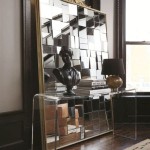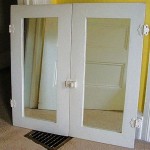The Enduring Allure of Large Victorian Mirrors
Large Victorian mirrors represent a significant period in decorative arts, embodying the opulence, craftsmanship, and stylistic evolution of the 19th century. These mirrors were not merely functional objects; they were statements of wealth, taste, and social standing, playing a crucial role in the Victorian interior design aesthetic. Their size, ornate detailing, and historical context contribute to their enduring appeal, making them highly sought-after pieces for collectors and interior designers alike.
The Victorian era, spanning Queen Victoria's reign from 1837 to 1901, was a time of profound social, economic, and technological change. This period witnessed the rise of industrialization, which, while bringing about mass production, also fostered a desire for elaborate decoration and ornamentation. The Victorian home became a showcase of personal expression, filled with an eclectic mix of styles and influences. Mirrors, especially large and elaborately framed examples, were considered essential elements in achieving this aesthetic.
The development of plate glass technology played a crucial role in the popularity of large mirrors. Prior to the Victorian era, creating large, flawless sheets of glass was a difficult and expensive process. The advent of improved manufacturing techniques allowed for the production of larger, clearer mirrors at a lower cost, making them more accessible to a wider range of consumers. This technological advancement spurred the demand for larger mirrors, further fueling the creativity of Victorian designers and craftsmen.
Victorian mirrors were frequently placed in prominent locations within the home, such as hallways, drawing rooms, and dining rooms. They served multiple purposes: reflecting light to brighten the space, creating an illusion of greater size, and serving as decorative focal points. A strategically placed large mirror could dramatically transform a room, enhancing its perceived depth and grandeur. This careful consideration of placement underscores the importance of mirrors in Victorian interior design.
Key Characteristics of Large Victorian Mirrors
Identifying a genuine Large Victorian Mirror involves understanding its defining characteristics, including materials, design motifs, and construction techniques. Several key features can help distinguish these mirrors from later reproductions or pieces from other periods.
Firstly, the frames of Victorian mirrors were typically crafted from high-quality materials, such as mahogany, walnut, rosewood, and giltwood. These woods were chosen for their durability, rich color, and ability to be intricately carved. Giltwood frames, often adorned with gold leaf, were particularly popular for reflecting light and adding a touch of luxury. The quality of the wood and the craftsmanship evident in the carving are indicative of the mirror's authenticity and value.
Secondly, the design motifs employed in Victorian mirror frames were diverse and often elaborate. Common motifs included floral patterns, scrolls, shells, acanthus leaves, and classical figures. These decorative elements were often inspired by historical styles, such as Rococo, Gothic Revival, and Renaissance Revival. The level of detail and intricacy in the carving is a hallmark of Victorian craftsmanship. Mirrors might also incorporate gesso work, a plaster-based relief decoration often gilded or painted.
Thirdly, the glass itself is an important factor. Victorian mirrors typically used plate glass, which, while innovative for its time, may exhibit slight imperfections or variations in thickness. The silvering process used to create the reflective surface also differs from modern techniques. Older mirrors may display signs of age, such as subtle clouding or foxing (small dark spots), which, while considered imperfections by some, are often seen as evidence of the mirror's history and authenticity. However, excessive damage to the glass can detract from the mirror's value and aesthetic appeal.
Common Styles and Types of Victorian Mirrors
The Victorian era encompassed a wide range of styles, each with its distinct characteristics. This diversity is reflected in the various types of mirrors produced during this period. Understanding the different styles can aid in appreciating the breadth and artistry of Victorian mirror design.
One prominent style is the Rococo Revival, which drew inspiration from the ornate and asymmetrical designs of the 18th-century Rococo period. Rococo Revival mirrors often feature elaborate frames adorned with scrolls, shells, and floral motifs. The frames are typically gilded and boast a sense of movement and exuberance. These mirrors were particularly popular in the mid-Victorian era.
Another significant style is the Gothic Revival, which embraced architectural elements and decorative motifs associated with medieval Gothic architecture. Gothic Revival mirrors often feature pointed arches, trefoil designs, and intricate tracery patterns. The frames are typically made of dark wood, such as mahogany or walnut, and may incorporate religious symbols or heraldic crests. This style reflected a renewed interest in medieval history and craftsmanship.
The Aesthetic Movement, which emerged in the late Victorian era, emphasized beauty and artistic expression over strict adherence to historical styles. Aesthetic Movement mirrors often feature simpler, more streamlined designs with a focus on natural motifs, such as flowers, birds, and butterflies. The frames may be inlaid with mother-of-pearl, ivory, or other precious materials. This style reflected a growing appreciation for Eastern art and design principles.
Pier mirrors, tall and narrow mirrors designed to be placed between windows or along walls, were also popular during the Victorian era. These mirrors typically feature elaborate frames and are often topped with decorative crests or pediments. Pier mirrors were used to create a sense of height and spaciousness in Victorian interiors.
Preserving and Maintaining Large Victorian Mirrors
Due to their age and delicate nature, Large Victorian Mirrors require careful handling and maintenance to preserve their beauty and value. Proper cleaning, storage, and restoration techniques are essential for ensuring their longevity.
Cleaning Victorian mirrors should be done with caution. Avoid using harsh chemicals or abrasive cleaners, as these can damage the glass and the frame. A gentle solution of warm water and mild soap is typically sufficient for cleaning the glass. Use a soft, lint-free cloth to wipe the surface, and be sure to dry it thoroughly to prevent water spots. For gilded frames, use a soft brush to remove dust and debris. Specialist cleaners designed for antique gilded surfaces are available, but always test them in an inconspicuous area first.
When storing a Large Victorian Mirror, protect it from extreme temperatures and humidity, as these can damage the glass and the frame. Store the mirror in a dry, well-ventilated area, away from direct sunlight. Wrap the mirror in acid-free paper or bubble wrap to protect it from scratches and other damage. If the mirror is particularly fragile, consider having it professionally crated for storage.
Restoration of Victorian mirrors should be entrusted to experienced professionals who specialize in antique furniture and mirrors. Attempting to repair or restore a Victorian mirror without the necessary skills and knowledge can cause irreparable damage. A professional restorer can assess the condition of the mirror and recommend appropriate treatments, such as repairing damaged frames, replacing broken glass, and re-silvering the reflective surface. Re-silvering is a delicate process that requires specialized equipment and expertise. A poorly executed re-silvering can diminish the mirror's value and authenticity.
Regular inspection is also important. Look for signs of damage, such as cracks in the glass, loose frame joints, or flaking gilding. Addressing these issues promptly can prevent further deterioration and minimize the need for more extensive repairs in the future. Preservation is key to ensuring that these magnificent mirrors continue to be admired and appreciated for generations to come.

Large Victorian Giltwood And Composition Mirror Lassco England S Prime Resource For Architectural Antiques Salvage Curiosities

Antique Victorian Mantle Mirror Wells Reclamation

A Large Victorian Mantle Mirror

Very Large Gilt Mirror Antique Mirrors At Straffan Antiques

Antique Victorian Mirrors

Victorian Mirror In White Home Decor Interior Design

Victorian Classical Large Antique Mirror Westland London

38 Best Victorian Mirror Ideas Wall

A Large Late Victorian Gilt Pine And Composition Overmantel Mirror Lassco England S Prime Resource For Architectural Antiques Salvage Curiosities

Sold At Auction A Large Victorian Gilt Wood Wall Mirror








